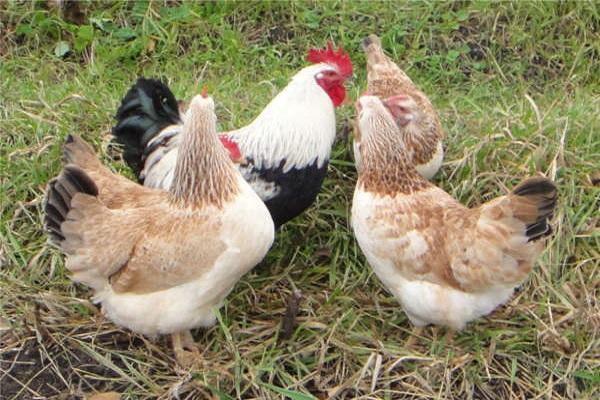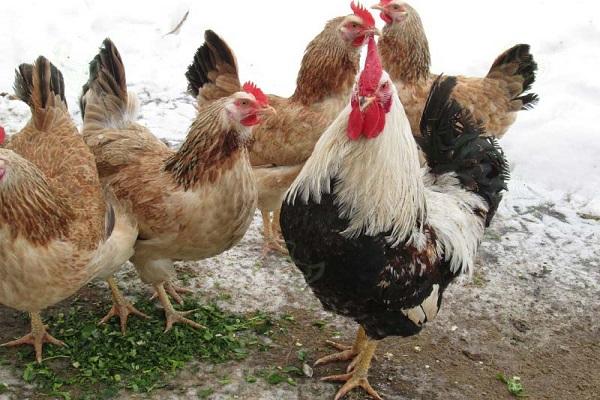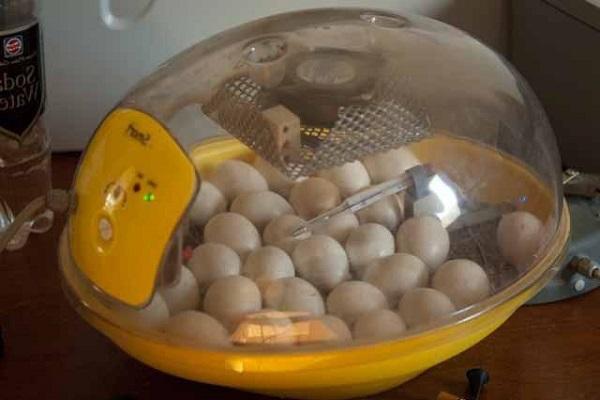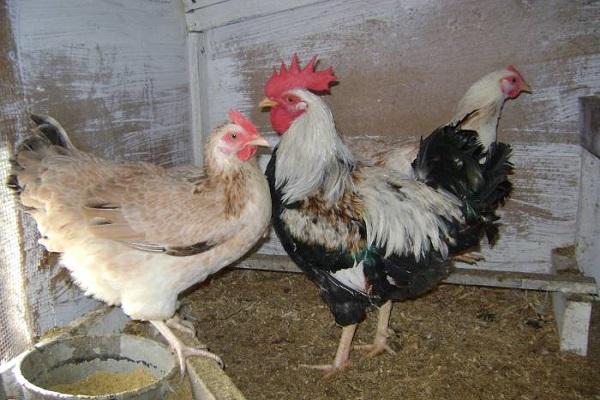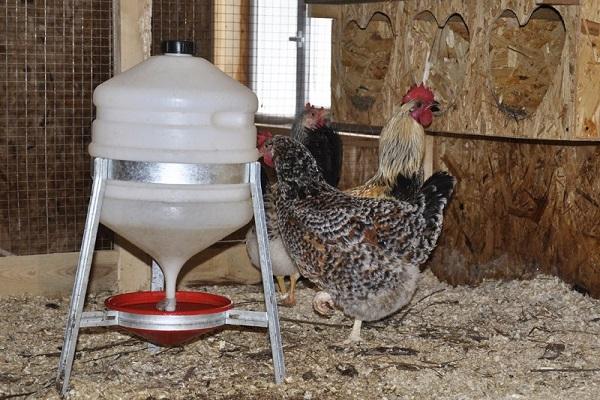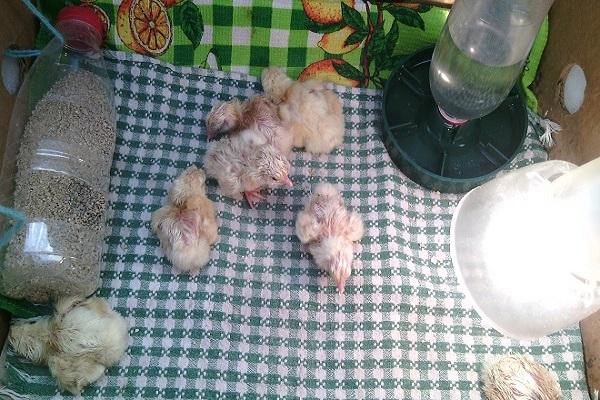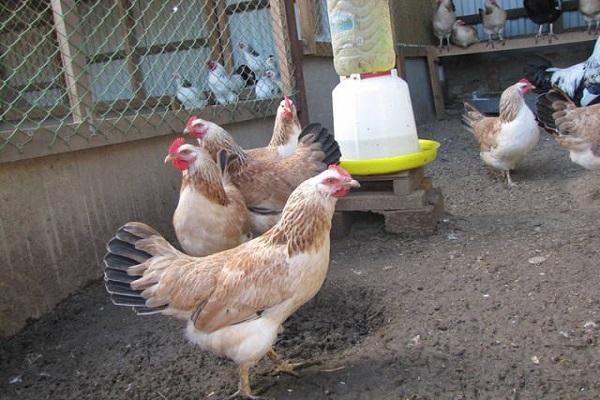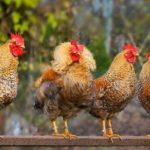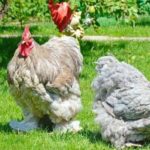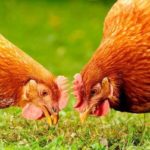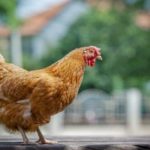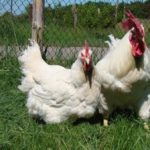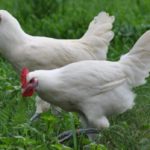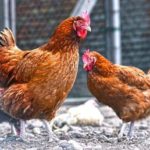Although breeders have developed many new breeds of chickens, Zagorsk salmon are happily kept in private backyards. Poultry rarely gets sick, eats everything, is highly productive, has a peaceful character, and an attractive appearance. Roosters do not attack children and do not fight each other until they bleed. Chickens grow quickly, weighing about 2 kg at 3 months.
- Breeding history
- Description and characteristics of the breed
- Appearance of Zagorskaya salmon chickens
- Character of birds
- Productivity
- Meat
- Eggs
- Main positive and negative aspects
- Recommendations for maintenance and care
- Chicken coop, feeders and drinkers
- Walking yard
- Bird molt
- Diet
- Chicks
- Adult herd
- Breeding specifics
- Possible problems
- Price
Breeding history
Salmon chicken was created at a research institute that worked in the small town of Zagorsk in the nineties of the last century. To obtain a hardy bird that lays large eggs, foreign New Hampshire and Rhode Island chickens were crossed with Soviet chickens. The rooster acquired a silver-black color, the female acquired salmon plumage.
Description and characteristics of the breed
The Zagorsk bird inherited its best features from its closest ancestors. The chicken is not afraid of the cold, feels normal in mid-latitudes, does not require expensive feed, and quickly gains weight. Even tiny chicks can tell the sex of a bird.
Cockerels hatched from eggs have a light yellow color, the back of females is covered with dark spots. After a few days, the chicks begin to have feathers that are black in the cockerels; the complete opposite color is typical for the females. They are light red.
Appearance of Zagorskaya salmon chickens
The bird's body is proportionally folded, its structure is clearly visible. Both females and roosters have an elongated body and a small tail. The bird's crest, painted pink, has blunt ends, the body is covered with salmon or whitish feathers, and black tones are found in the tail.
The rooster has a light head, the same neck, the rest of the body has variegated shades.
The chicken's yellow beak is slightly curved, its strong legs are of medium length. Earrings, earlobes and eyes are red.
Character of birds
The breed, created in the USSR, is energetic, flies over high fences, and gets along well with other chickens. The bird does not like to sit still, and when released into the wild, it travels through the beds, exploring gardens and vegetable gardens.With strong paws, she pulls out worms and destroys not only the above-ground parts of plants, but also the roots. Salmon chickens are kept behind a fence.
Males do not attack their owner, react calmly to roosters of other breeds, do not fight their rivals until they bleed, and if they fight, they quickly disperse in different directions..
Productivity
Salmon chickens do not complain about appetite. In 90 days, roosters gain at least 2 kg, and adult males weigh 3.5–3.7 kg.
Meat
Chicken is rich in proteins and has a pleasant aroma. 100 grams of the product contains up to 200 kcal, so it is used in dietary nutrition. The Zagorsk breed of chickens is valued for its healthy and tasty meat. Females are fattened up to 2 kg, roosters - up to 3. If improperly fed, the bird's comb turns pale and enlarged, and obesity occurs.
Eggs
Salmon chickens are bred not only to produce nutritious and dietary meat. Healthy females begin to lay eggs at the age of 100–120 days and produce an average of 200 eggs per year, the weight of which in young chickens is 46–50 g, in adults it reaches 65. They contain a lot of useful components in the form of:
- carotene;
- folic acid;
- Selena;
- luteins.
The fertilization rate of chicken eggs covered with a brown shell exceeds 90%. Only 7–10% of hatched chicks die, the rest grow quickly and reach sexual maturity at 5 months.
Main positive and negative aspects
Many chickens have been bred whose appearance is much more interesting than that of the salmon breed, but the Zagorsk bird has many other advantages, these include:
- high productivity;
- resistance to cold;
- ease of care;
- presence of immunity to infection;
- rapid weight gain.
Peaceful females hatch chickens of other breeds. The disadvantages of Zagorsk chickens include a tendency to obesity.The bird's digestive organs absorb everything it can find.
Curious chickens fly over the fence to peck flowers and trample vegetables, but the high fence does not keep them from doing this.
Recommendations for maintenance and care
Despite the fact that the Zagorsk breed is not afraid of the cold, it must be provided with an insulated home and at least a minimum of care, otherwise the females will lay eggs poorly and the males will gain weight more slowly.
Chicken coop, feeders and drinkers
It is not recommended to keep salmon breeds in cages. Active birds do not tolerate cramped conditions because they love space. To set up a home for chickens:
- They dig a hole for the foundation, taking into account that at least a meter of area is needed for one bird, and fill it with concrete.
- 2-meter walls are made from wood board or stone.
- The holes are covered with putty.
- The roof is made from roofing felt.
- The floor is covered with boards and covered with sawdust.
The poultry house must have at least one window and tightly closing doors. Perches are installed at different levels. A drinking bowl is installed at the bottom of the wall and a feeder is placed. In winter, the poultry house is ventilated every day, in the spring it is cleaned, the floor and walls are limed, and the bedding is changed. The feeder and drinking bowl are treated with an antiseptic once a month.
Walking yard
Near their home, birds leave an area fenced with a high metal mesh. A canopy is built on it from slate and boards, which will protect the chickens from the rain. A drinking bowl is also installed at the walking area, and river sand is poured into the feeding trough. Birds that run in fresh air lay eggs better. Eggs contain more vitamins and minerals. Active chickens tend to get into the garden; they must be walked.
Bird molt
In the first spring, when laying hens reach puberty, they shed their plumage. Renewal of the epidermis in the Zagorsk breed does not last long; the chicken easily tolerates this natural process. The bird's neck moults first, followed by its back. Then the feathers on the belly and wings fall out. In adult salmon chicken, this phenomenon is observed extremely rarely and occurs due to a lack of microelements due to an attack by helminths.
Diet
Zagorsk chickens never refuse food; they feast on the peels of boiled potatoes. They consume any feed, grain, greens.
Chicks
Chickens hatched from an egg eat its yolk, and this is enough for the kids for half a day. During the first week, chickens are recommended to be given corn grits every 2 hours. After a few days, the chicks’ diet includes:
- chopped nettle;
- cottage cheese;
- boiled potatoes;
- fresh onion.
The chickens are given a weak solution of potassium permanganate and given Bifidumbacterin, which helps normalize the microflora. When the chickens are 2 weeks old, they can be fed not only wheat or barley cereal, but also soaked bread and boiled fish. Chickens are given food up to 7 times a day.
Month-old chicks are released into the yard, where they happily peck at the greens. The chickens' diet includes waste meat, vegetables, fermented milk products, and coarse grains. Care must be taken to ensure that young birds do not eat worms. At the age of 15 days, chickens are given grass and continue to be fed with boiled yolk and white.
Adult herd
At three months, Zagorskaya chickens are already devouring the remains of soup and borscht, young chickens rejoice at the leftovers from the master’s table, and enjoy eating corn with pleasure. In addition to grain, birds are given feed, bran, fish oil, and ground bones.Sand is added to porridge.
Chickens that lay eggs need protein, fresh greens, which contain a lot of vitamins. To make the shell stronger, the birds are fed bone meal and chalk; they should not be given rotten foods or potato sprouts.
Breeding specifics
Zagorsk breed chickens hatch chicks without any problems. It is recommended to place the hen in a cage so that other birds do not distract her from hatching her offspring.
For the incubator, farmers select large eggs and leave them for 24 days, gradually reducing the temperature from 38 to 37 °C. The hatched chicks behave actively, eat the yolk, and less than a month later they peck the same thing as the adult birds.
Possible problems
Although Zagorsk chickens are immune and adapt to unfavorable climate conditions, they sometimes suffer from diseases. A bacterial infection affects several chickens at once, negatively affecting different organs. Birds can contract salmonellosis, which causes swollen eyes and joints and diarrhea. They are treated with Furazolidone.
Chickens become infected with cholera from pigeons or rodents. The disease manifests itself:
- temperature rise;
- breathing problems;
- presence of blood in excrement.
The use of sulfa drugs helps save a flock of birds. Pathogenic organisms settle in the tissues of chickens, damaging feathers and injuring the skin. Parasites infest the digestive tract of birds and destroy internal organs. To prevent the entire flock from dying, infected chickens must be isolated from healthy birds.
If individuals are in unsanitary conditions or in crowded conditions, the home is not cleaned or disinfected, and the chickens develop diseases, but in this case it is enough to clean the house, change the bedding, and carry out disinfection.
Sometimes the hen drives away other females; the problem can be solved by transplanting the chicken into a separate cage. It happens that old birds peck young animals, which usually happens when individuals are kept in close quarters.
Price
Farmers and village residents are happy to raise salmon chickens. Unpretentious birds have tasty meat, grow quickly and gain weight, lay large eggs, and are sold at an affordable price. For a young chicken or cockerel of the Zagorsk breed at the market they ask for 400–500 rubles.

